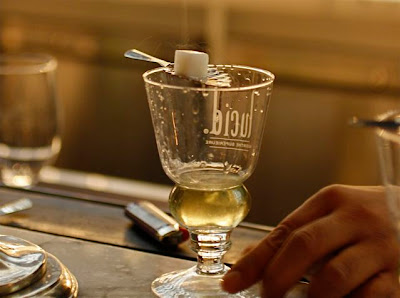
Absinthe is distilled from a mixture of whole herbs in alcohol. These herbs include grande wormwood (Artemisia absinthium), green anise, sweet fennel and other culinary plants.


Created as a medicinal elixir by a French doctor living in Switzerland around 1792, it achieved great popularity as an alcoholic drink in late 19th- and early 20th-century France, particularly among Parisian artists and writers where the drink was said to act as an aphrodisiac and stimulate creativity.

The Absinthe Fountain
"Rimbaud's Poison"
"The emerald hour when the poet's pain is soothed by a liquid jewel held in the sacred chalice, upon which rests the pierced spoon, the crystal sweetness, icy streams trickle down. The darkest forest melts into an open meadow. Waves of green seduce. Sanity surrendered, the soul spirals toward the murky depths, wherein lies the beautiful madness - absinthe."

The bar at Chaya Downtown in Los Angeles, and our Absinthe Guide (bartender) Victor.

He pours ice water into the absinthe fountain.

Then pours 1 oz. absinthe into the special glass. Places a sugar cube over an absinthe grille or spoon in a saucer and soaks the sugar cube with absinthe.

Traditionally, the sugar cube is not ignited, as purists believe the caramelized sugar detracts from the herbal flavors. Apparently the use of fire in the absinthe ritual is a newer phenomenon was not a part of the custom during the Belle Époque. Sugar is used to cut the bitterness of the strong herbal spirit.

The spoon is placed over the glass and the sugar is lit on fire. As the sugar begins to caramelize, the absinthe water drip is begun.

Ice water from the absinthe fountain spigot slowly drips over the sugar into the glass, extinguishing the flame and melting the sugar and sweetening the absinthe.

L'Absinthe
Edgar Degas
1876
Oil on canvas

The cold water releases the oils from the absinthe, unlocking the powerful anise bouquet, and causing it to louche or cloud up into a light opalescent green. Absinthe is usually diluted in a 1:3 or 1:5 ratio to water. La louche has a symbolic meaning as well - As the water transforms the absinthe, so will the absinthe transform the mind.
La Fee Verte
The Green Fairy is the affectionate French nickname given to absinthe.

Can you spot the green fairy?

Absinthe had been portrayed as a dangerously addictive psychoactive drug. The chemical thujone, present in small quantities, was singled out and blamed for its alleged harmful effects. By 1915, absinthe had been banned in the United States and in most European countries.
Although absinthe was vilified, no evidence has shown it to be any more dangerous than ordinary spirits. Its psychoactive properties, apart from those of alcohol, have been much exaggerated.
Absinthe’s popularity grew steadily through the 1840s, when absinthe was given to French troops stationed in North Africa as a disease preventative. When the troops returned home to Paris, they brought their taste for absinthe with them. It became so popular in bars, bistros, cafés, and cabarets that, by the 1860s, the hour of 5 p.m. was called l’heure verte (the green hour).
A revival of absinthe began in the 1990s, when countries in the European Union began to reauthorize its manufacture and sale. In 2007 French absinthe "Lucid" was the first authentic absinthe brand to be legally imported to the US since the ban in 1912. The absinthe must contain less that 10 mg/kg of thujone to be legally imported. Also that year, the first batch of legally produced absinthe was made in California.

Absinthe produced for consumption outside the US can contain up to 100 mg/kg thujone, like Century Absinth. Some aficionados claim that this is the true absinthe which creates the "effects" cherished by famous absinthe drinkers of the day: Edouard Manet, Paul Verlaine, Arthur Rimbaud, Oscar Wilde, Henri de Toulouse-Lautrec, Vincent Van Gogh, Paul Gauguin, Pablo Picasso, and Ernest Hemingway.